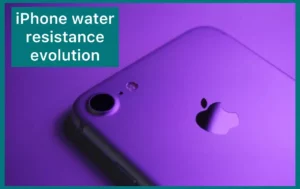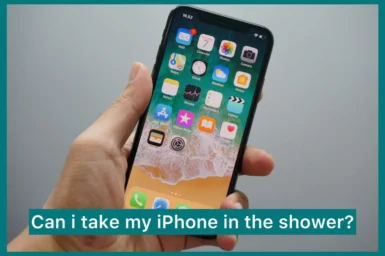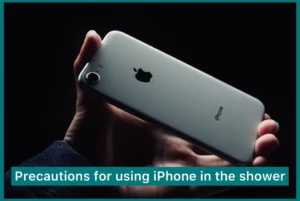Are you confused if you could take your cherished iPhone device in the shower? This frequent question shows how much we depend on smartphones.
This article will examine every aspect of the iPhone’s water resistance and determine whether taking your iPhone is safe or a disaster waiting to occur.
iPhone Water Resistance Evolution
Water-resistant technology has grown significantly with each newer model.

iPhone 7
Several changes have been made to the iPhone’s water resistance across different models. Apple introduced its first IP67-rated device, able to withstand splashes and brief submersion in water, with the iPhone 7 model. This pattern was continued by later models such as the iPhone 8, X, and XR.
iPhones XS and XS Max
iPhone XS and XS Max changed the game with their improved water resistance With an upgraded IP68 classification that allows them to withstand submersion up to 2 meters for 30 minutes. The iPhone 11 series kept this certification, making them more resistant to accidental contact with water.
iPhone 12, 13, 14, and 15
The IP68 trend is continued by Apple’s most recent models, including the iPhone 12, 13, 14, and 15. These models promise long-lasting water resistance without compromising other features.
These can be submerged in water for 30 minutes up to a depth of 6 meters and are dust-tight. Because of these developments, using your iPhone near water, such as at a pool or during light rain, is now generally less dangerous.
But it’s important to remember that warranties might not always cover water damage, so you should proceed cautiously.
Caution and Considerations
Although iPhone water resistance has advanced significantly, it’s important to remember that warranties might not always cover water damage.
Using caution while putting your device in water is recommended, and following Apple’s recommendations for water resistance is important to prevent any problems.
Can You Take Your iPhone in The Shower?
For iPhone users of all models, taking their phone into the shower has been a source of interest and worry. Apple has gradually increased the water resistance of its iPhones, starting with the iPhone 7 and continuing through the most recent models, the iPhone 14 and iPhone 15.
Even though these more recent models have great IP68 certifications and can withstand accidental water exposure like spills and brief submersion, it’s important to remember that putting your iPhone into the shower on purpose is not advised.
The shower environment can present dangers not covered by warranty because of the steam, moisture, and changing water pressure. Even with improved water resistance, it’s wise to use caution and put your iPhone’s durability first by avoiding needless water exposure.
If you must use your iPhone while taking a shower, consider purchasing a waterproof case or simply keeping it far away from the water to reduce dangers.
In the end, even though iPhones have improved their water resistance over time, they are still not waterproof, and caution is still advised while using water with electronic devices.
Precautions for Using an iPhone in the Shower
Although it can be tempting to use your iPhone in the shower, there are risks that could harm the device. If you decide to leave your iPhone close by while taking a shower, take the following safety measures to keep it secure:
1. Get a Waterproof Case
Investing in a high-quality waterproof case for your iPhone is one of the best safety measures. These covers act as a shield between the device and water, protecting it from possible damage.
2. Keep It at a Safe Distance
To reduce exposure to water and steam, keep your iPhone away from the showerhead if a waterproof case isn’t an option. Use a shelf or a separate dry space in the bathroom, if possible.
3. Avoid Direct Water Contact
Keep your iPhone away from any direct water contact. Through holes, water droplets can get into the device and possibly cause damage. Keep it far from the water’s flow.
4. Use Wireless Accessories
To enjoy entertainment during your shower without risking the security of your iPhone, invest in Bluetooth or wireless accessories like speakers or earbuds. You’re able to remote-control your device with these accessories.
Check for Damage
- After taking a shower ,look for any evidence of moisture on your iPhone.
- Pay particular attention to the speaker grilles and charging port.
- Turn off your device and let it fully dry if you encounter any problems.
What to Do If The iPhone Got Wet?
You must act fast if your iPhone gets wet to avoid any harm. Here is what you should do:
1. Remove it from the water Immediately: If your iPhone has been in contact with water, remove it immediately. The risk of harm increases the longer it stays in water.
2. Turn Off the Device: If your iPhone is still powered on, turn it off right away. It could short-circuit if you attempt to use it.
3. Remove SIM card: Eject the SIM card tray and take out the SIM card to remove it. This will lessen the chance of the SIM card slot and the card being harmed.
4. Dry the Outside: Lightly pat the outside of the iPhone dry with a dry cloth or paper towel. Avoid using heat sources like hair dryers since too much heat can harm the device even more.
5. Shake Out Extra Water: Shake the device gently while holding it with the charging port facing down to eliminate any extra water that may have gotten into the ports or openings.
6. Don’t Use Rice: Contrary to what many people think, putting your iPhone in a bag of rice is not the best solution. In fact, it can force water further into the apparatus. Focus on air drying instead.
7. Air Dry: Place your iPhone in an airy, dry, warm (but not hot) environment. For a minimum of 24 to 48 hours, it’s ideal to let it air dry. You can set it down on a fresh towel or a drying rack to allow for airflow.
8. Avoid Charging: Wait until you are positive that your iPhone is dry before charging it. A moist device may suffer additional harm if it is charged.
9. Test the device: Turn on your iPhone to test it out after it has sufficiently dried. Verify that the buttons, speakers, camera, and screen are all functioning properly. Contact Apple Support for additional analysis if any problems continue.
Remembering that water damage may not always be covered by warranty is important, so if your iPhone gets wet, you must act right once. The best strategy for preventing possible harm in the first place is prevention.
Conclusion
Water resistance in iPhones has advanced significantly, providing better defense against unintentional exposure. Using your iPhone in the shower is still risky; however, it can be reduced with safety measures, including waterproof cases, secure placement, and wireless accessories.
If your iPhone becomes wet, immediate and careful action is essential to avoid harm. Always put your device’s longevity first, and keep in mind that some warranties might not cover water damage, so being preventative is the best course of action.


